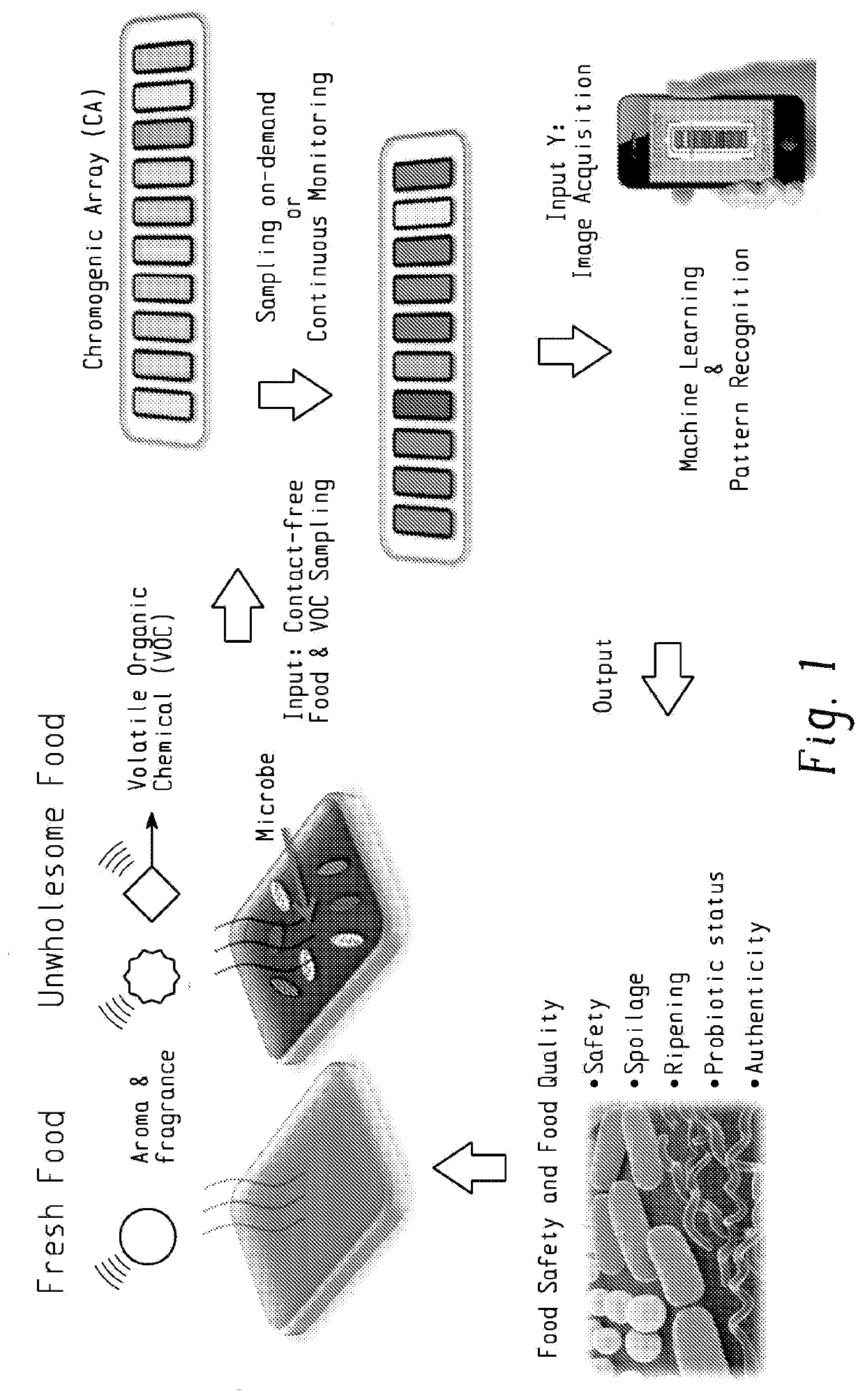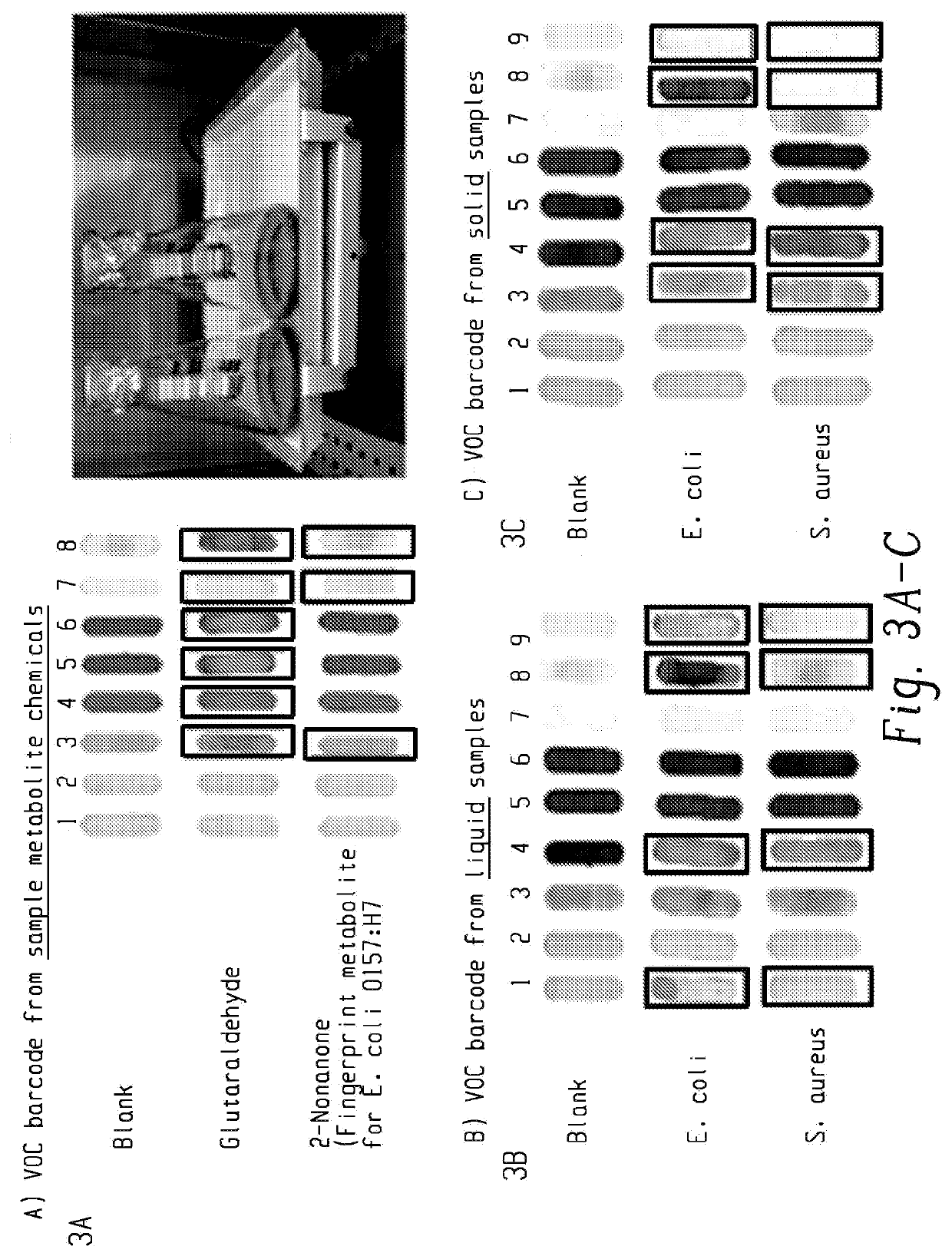Method and System for Chromogenic Array-Based Food Testing
a technology of chromogenic arrays and food testing, applied in the direction of dairy products, testing, chemical indicators, etc., can solve the problems of reducing food-borne illness outbreaks, costly recalls and market withdrawals, and not meeting the needs of rapid quantification
- Summary
- Abstract
- Description
- Claims
- Application Information
AI Technical Summary
Benefits of technology
Problems solved by technology
Method used
Image
Examples
example 1
Design of an Array Test Strip
[0059]FIG. 1 illustrates an embodiment of a CA test strip. Briefly, viable pathogens produce volatile organic compounds in the headspace, as well as soluble metabolites in a food matrix during microbial metabolism. An array of integrated dyes, printed on a test strip, reacts with the target volatile organic compounds and metabolites. A short (15 minutes) direct sampling of the food or headspace will render color changes of the array dyes. An integration of 20 or more dyes will appear as arrays, which maximize the ability to differentiate a large variety of volatile organic compounds from foodborne pathogens. A machine learning algorithm adopted as a computer or cell phone-aided pattern recognition can extract information regarding pathogen identity and quantity. In addition, each CA has built-in color standard in red, green, blue, and white, that do not change color over time and when exposed to VOC. The color standards serve as a correction and standard...
example 2
on of Preliminary Array Test Strips in Microbial Samples
[0067]CA assay was developed and validated on its capability to differentiate viable pathogen at high specificity and selectivity. CA color pattern was generated using single culture viable pathogens at various concentrations and growth conditions (including media, model food, temperature, pH, gas atmosphere, and simulated food processing and storage conditions).
[0068]The CA was used for microbial samples testing. All major foodborne pathogens, including non-typhoidal Salmonella, Listeria monocytogenes, Campylobacter, Clostridium perfringens, Vibrio vulnificus, Shigella, and STEC non-O157:H7 were included. The strains were revived from −80° C. by growing in BBL′ BHI broth (Becton, Dickinson and Company, Sparks, Md.) overnight to obtain standard microbial cultures and spreading on an agar petri dish (Difco™, Becton, Dickinson and Company, Sparks, Md.) to provide single colonies. To determine volatile organic compound from liquid...
example 3
ty and Quantitative Modeling
[0070]To determine the CA sensitivity or limit of detection, the color patterns obtained at different microbial population were studied. An appropriate volume of overnight E. coli (ATCC 8939) culture was inoculated in an Erlenmeyer flask containing 30 mL BHI broth with the initial concentration at 103 CFU / mL. The flask was incubated at 37° C. for 16 hours. CA color change patterns at different time points were retrieved and the microbial population was counted using a standard plate counting method. As shown in FIG. 5 (a), the CA exhibited obvious color change over the 16-hour E. coli growth. The visible color change of CA pattern can be observed starting after 6 hours incubation. With the microbial population from FIG. 5 (b), the minimal microbial population need to show visible color change is about 106 CFU / mL. The color pattern was both time-dependent and concentration-dependent.
[0071]The CA color pattern was processed and modeled using machine learnin...
PUM
 Login to view more
Login to view more Abstract
Description
Claims
Application Information
 Login to view more
Login to view more - R&D Engineer
- R&D Manager
- IP Professional
- Industry Leading Data Capabilities
- Powerful AI technology
- Patent DNA Extraction
Browse by: Latest US Patents, China's latest patents, Technical Efficacy Thesaurus, Application Domain, Technology Topic.
© 2024 PatSnap. All rights reserved.Legal|Privacy policy|Modern Slavery Act Transparency Statement|Sitemap



